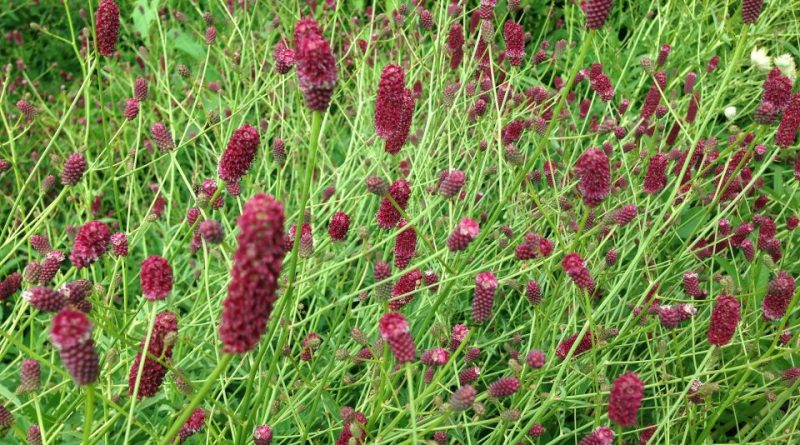Sanguisorba officinalis
Sanguisorba officinalis
Great burnet (Sanguisorba officinalis L.) is a herbaceous species belonging to the Rosaceae family.
Systematics –
From the systematic point of view it belongs to the Eukaryota Domain, Kingdom Plantae, Sub-Trinchebionta Subdivision, Spermatophyta Superdivision, Magnoliophyta Division, Magnoliopsida Class, Subclass Rosidae, Rosales Order, Rosaceae Family, Subfamily Rosoideae and then to the Genus Sanguisorba and the Species S. officinalis.
Etymology –
The term Sanguisorba comes from sanguis blood and from sorbeo absorb: due to the anti-haemorrhagic action attributed to plants of this genus. The specific officinalis epithet comes from the medieval laboratory offícina: due to the therapeutic properties of this plant.
Geographical Distribution and Habitat –
Sanguisorba officinalis is a plant native to the cold areas of the northern hemisphere of Europe, northern Asia and northern North America.
In Italy it is found mainly in the northern areas and more rarely in the south, while it is absent in the islands. Its habitat is represented by wetlands, meadows and cool places, rich in organic substance, from the plain up to more than 2,000 meters.
Description –
The great burnet is a herbaceous, perennial, rhizomatous species, which develops between 30 and 100 cm.
It has imparipinnate leaves with 5-9 oval or lanceolate segments, sharply serrated on the margin and obtuse at the apex.
The flowers are small and devoid of petals, gathered in dense ovoid red-black or purple heads that bloom at the apex of the stem.
The infructescence is a pometo, of 2.5-5 x 0.8-3 mm, constituted by the receptacle (ipanzio) urceolate, accrescente, dry, ellipsoid, with 4 ribs with narrow wings and smooth faces. Inside it contains only one achene.
The flowering period fluctuates between May and August.
Cultivation –
For the cultivation of great burnet it is advisable to choose calcareous soils, not very humid, in sunny areas, taking care to make a bottom fertilizer based on mature manure. The plant can be reproduced by seed or division of the rhizomes. In cultivation starting from seed the most suitable period is that of March, sowing outdoors, in rows 25 to 30 cm apart. to obtain a longer production of leaves it is good to gradually eliminate the flowers that are forming.
It is also cultivated as a border plant due to its elegant leaves and the purple-purple brush-like inflorescences.
Uses and Traditions –
Sanguisorba officinalis, known by the common names of Sanguisorba, Salvastrella maggiore or Pimpinella is a plant that boasts anti-inflammatory, digestive, aperitif, astringent, haemostatic and tonic properties. It can be used for external use as a cleanser and soothing for inflamed skin and mucous membranes. It treats stomach ailments, meteorism, hemorrhoids, cystitis, bladder stones. It is used in the form of a decoction or infusion. For this purpose all areas of the plant are used.
Historically, the Shen Nong Herbal Canon, written during the Western Han dynasty (206 BC and 22 AD), is the first evidence of the use of the roots of this plant for therapeutic purposes in China. In western medicine, on the contrary, the use of leaves has always been privileged.
This plant has been used in traditional Chinese medicine (TCM) where it is known as Yu. It is said to cool the blood, be hemostatic, remove inflammation and heal wounds (Chinese Herbal Materia Medica by Dan Bensky).
In folk medicine, the root is used to stop bleeding dysentery, blood from the nose and is applied locally to treat burns and insect bites.
Sanguisorba officinalis has interesting uses in ecological restoration practices due to its extensive root system for erosion control, as well as a bio-remediation, used to recover abandoned sites such as landfills.
Furthermore, this plant is an important food plant for the large European blue butterflies Maculinea nausithous and Maculinea teleius.
Preparation Mode –
Of the great burnet it is possible to use the fresh leaves to flavor salads, soups, cheeses and cooked vegetables, to which they give a slight taste of cucumber.
The use of young leaves is recommended to increase the appetite.
The leaves should be collected and used fresh or dried in a shady and ventilated place.
Guido Bissanti
Sources
– Acta Plantarum – Flora of the Italian Regions.
– Wikipedia, the free encyclopedia.
– Treben M., 2000. Health from the Pharmacy of the Lord, Advice and experiences with medicinal herbs, Ennsthaler Editore
– Pignatti S., 1982. Flora of Italy, Edagricole, Bologna.
– Conti F., Abbate G., Alessandrini A., Blasi C. (edited by), 2005. An annotated checklist of the Italian vascular flora, Palombi Editore.
Attention: Pharmaceutical applications and food uses are indicated for informational purposes only, do not in any way represent a medical prescription; therefore no responsibility is assumed for their use for curative, aesthetic or food purposes.


